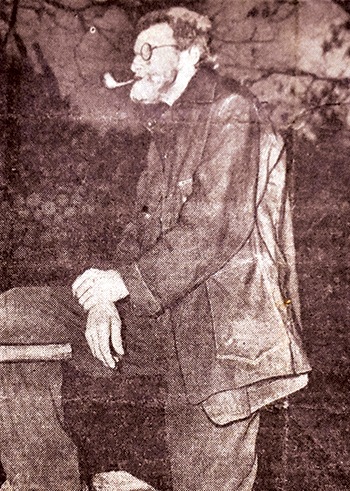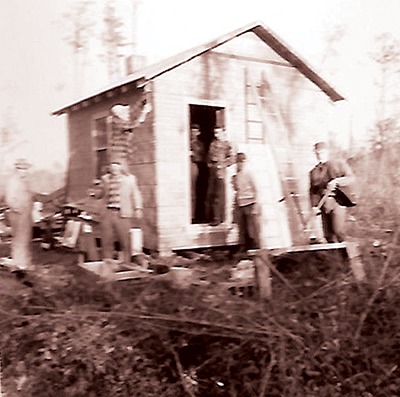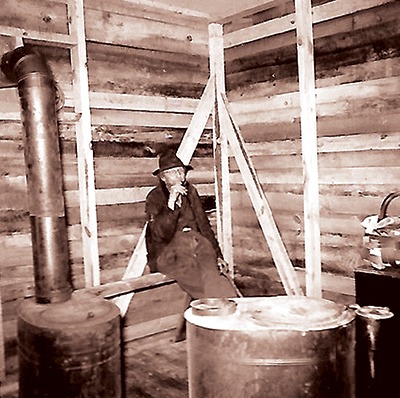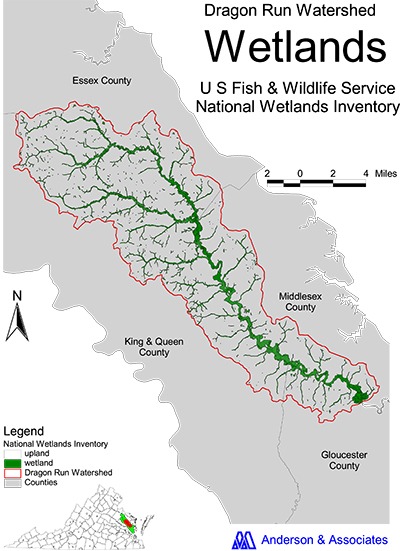by Larry Chowning –
If you were to run into Eddie Seward, the “Hermit of Stormont,” sometime in the 1940s to mid-1960s, he was not somebody you would ever forget.
“I first encountered Eddie Seward at approximately age 6,” said Joe David Parker, 75, of Roanoke. “We were walking in opposite directions on a dirt road leading from Stormont Road to Dragon Run. He had a long beard and was scary looking.
“My brother Billy told me he lived in a shack near the Dragon. I visited that shack and what’s still visible to me to this day is his bed. There was a board (bed) in a corner with straw all over it instead of a mattress,” he said.
“I remember seeing empty bean cans, oatmeal boxes and dishes and steel traps all over the place,” said Parker. “I hustled on out of there for fear he would catch me.”
Richmond Times Dispatch article

On Jan. 7, 1951 the Sunday edition of the Richmond Times Dispatch (RTD) carried a feature story written by Hamilton Crockford entitled, “Wildlife Lore Comes Naturally to Wilderness Man — Dragon Swamp’s Secrets All Known to Eddie Seward.”
Seward was 75 years old when the article appeared. He was born in the Stormont area and lived his entire life there. When the article was written, Seward was living in a hut off Stormont Road near Dragon Run.
Crockford wrote, “His tiny cabin stands back on his 100-acre woods on Dragon Swamp. … He has lived alone there for years, since the doctors told him to quit farming back about 1917 because of health reasons.”
Seward’s reflections in the story suggest he started life in a customary fashion, but a bad break with love laid the way to his unusual bachelor lifestyle. “There was a woman once, a good Christian woman who I planned to marry,” he said in the article. “But God wouldn’t let me have her. She died very suddenly.
“Since then there have been opportunities, like the widow who told me, ‘Eddie, you might get yourself a wife if you just fixed up a little.’
“I told her, ‘God will take me just as I am, and I’m not worrying about anybody else.’ “
A neighbor’s reflection
Robert Major of Stormont remembers Eddie Seward well. “We called him Uncle Eddie. He was not our uncle but he was related to us as a cousin to some degree. He was one of a kind I will tell ya that. He could read and write and would quote the Bible to us little boys as good as any minister I have ever heard.
“There was no welfare in those days. It was called relief and Uncle Eddie got relief,” said Major. “Part of his relief package was prunes and raisins and we children would go down to his hut to see him and we ate a many a prune and raisin in that hut. He also ate oatmeal a lot and he had hundreds of dishes and bowls that had come free from inside the oatmeal boxes. Dishes were everywhere — inside and out.
“He would work some. He provided Roger Callis (Callis General Merchandise Store in Stormont) with firewood in the winter to heat his store. He cut it all by hand and Roger got someone to go pick it up and bring it to his store.
“He worked the county’s bounty circuit. The county paid bounty on hawks, owls and crows. The bounty was 35 cents for a dead hawk and owl and 10 cents on crows. Uncle Eddie would build stands up high along the bank of Dragon Run where he would set his traps for the birds to stick their legs in.
The county also had 50-cent bounties on groundhogs and skunks. “He was a pretty good trapper,” said Major. “He knew every inch of the Dragon Run in the Stormont area; the frequent paths of animals; and he could tell you what animals were moving on the path.”
Living conditions

“Most people remember him living in a hut down on the Dragon but he moved around. One time, right after my grandfather died, he moved into his smokehouse and lived there for a while.
“Uncle Eddie owned 100 acres near the Dragon. When his hut was just about to fall down, we all got together in the neighborhood, men and boys, and built him a new shack. I helped build it. We built it near a spring so he would have water, but he seldom washed so his personal hygiene was pretty much nonexistent.
“He had enough support to live elsewhere, but he liked being alone. Like I say, he was different. He would tell us crazy stuff. One time he said he was fishing for bass on Dragon Run when a shark caught his line and dragged him all the way to Chesapeake Bay.
“He would go most every day up to Callis Store (Stormont) and sit on a wooden box out front along with other old men and they would talk mostly stupid stuff. He never slept in a proper bed. He would bed down in a bunch of fertilizer sacks or straw.
1948 run for board of supervisors
“For a lot of years, my mother had him for Sunday dinner. She would prepare a pot of greens with a big chunk of fatback. Uncle Eddie would eat the fatback and leave the greens,” said Major.
“He stopped coming to dinner after he lost the election for the Middlesex County Board of Supervisors seat. (Seward ran for the Saluda District seat in 1943. His announcement was in the Aug. 5, 1943 issue of the Southside Sentinel.)
“He only got 12 votes (in the November election) and he claimed daddy (John M. Major) didn’t vote for him. Daddy did vote for him but Uncle Eddie did not believe it so they got into it and Uncle Eddie stopped coming to our house for Sunday dinner. After that he went over to my uncle’s house to eat on Sundays. I guess my uncle was one of the 12 votes or at least Uncle Eddie thought so.”
How the Dragon got its name
In the Times Dispatch article Seward spoke to the mystery of the origin of the name Dragon Run. “This swamp was full of every kind of game once,” he said in the article. “But there wasn’t but one man that ever saw the kind that gave it the name. That was a man named Fary from Gloucester County who came here to fish every Sunday.
“One Sunday he happened to cast his eye up and there was something coming down with the tide towards him with a very peculiar look. It resembled a lion, but it wasn’t. It was larger than a lion.
“He (Fary) pulled up his anchor and left. He told his wife (of the creature), but wouldn’t let her tell. The old man never fished in the Dragon again after that day. It was after his death that his family found the story in his letters of the Dragon-looking Lion that he saw on that day.”
Love of squirrels

Major said that Seward had squirrels living in his hut with him. The Times-Dispatch article explains, “Ever since I was a child I was taught to try and take care of the dumb creatures. One day in June I spied a squirrel picking up pieces of walnuts I’d dropped and it carried ‘em down in the woods.
“I figured she had some young ones. And I gave her some nuts and tried to get her to come for ‘em, but she just scurried round the tree and barked at me. So I left ‘em in the doorway and she carried ‘em off.
“Two mornings later when she came begging. I said to her, ‘Betty — by then I’d named her — ‘if you want some nuts, go bring your babies here.’ And after awhile she came leading the six of ‘em.”
Seward fed the baby squirrels and “when I woke the next morning Betty was sitting on my knee barking at me to feed her and her babies. And do you know, in 30 days I had 35 squirrels out here to feed every morning. I could take the old ones in my hands — wild squirrels, mind you.”
Attempt to tame the spirit

At one point, the local authorities attempted to tame Seward’s spirit and got him to go into a nursing home in Wake. “We would go visit him but in no time he escaped. I guess he just walked out and went back to the Dragon,” said Major.
“I heard he was in Eastern State (mental hospital in Williamsburg) for awhile but he wasn’t crazy,” said Major. “He was just Uncle Eddie. He had chosen to live life a little different and it was hard for people to understand.
“I can tell ya the Dragon Run was in his blood and he lived and died on the Dragon,” Major said.
Edwin M. “Eddie” Seward is buried in one of two Seward family plots at Harmony Grove Baptist Church cemetery in Harmony Village. Cemetery information states only the years he lived. He was born 1876 and died in 1965 at the age of 89, it stated.
(Reporter Larry Chowning thanks Kitty Priddy, who provided a copy of the Jan. 7, 1951 Richmond Times Dispatch article on Eddie Seward and suggested that a story be written; Rebecca Major Robbins, who provided photos of Seward; and the authors of “Cemeteries in Middlesex County, Virginia,” a book published in 2001 and copyrighted by Pat Royal Perkinson and the Middlesex County Cemetery Survey Committee. The book confirmed the information on Seward’s gravesite.)



